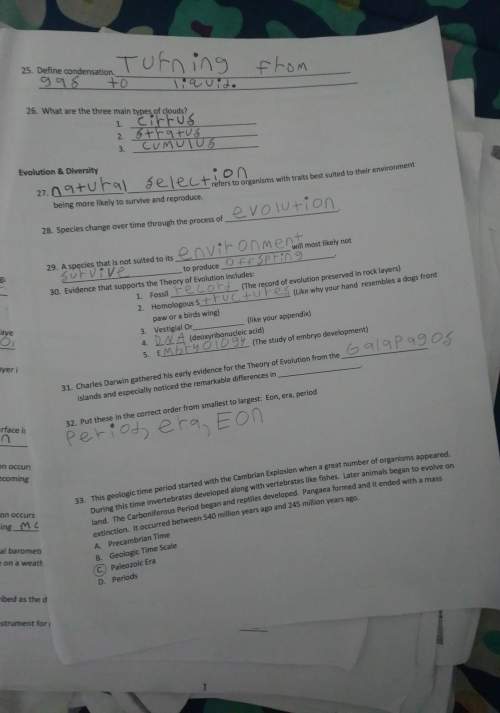
Physics, 08.12.2020 22:10 psitthibun
Background Information:
Work equals force times the distance through which the force acts. Force is expressed in newtons (N) and distance is expressed in meters (m). Work is expressed in newton-meters, or the simplification, joules (J).
The rate at which work is done is called power. Power equals work divided by time. If work is in joules (J) and time is in seconds (s), power is expressed in joules/second, or the simplification watt (W). James Watt was a British scientist who invented the steam engine. To find out how the power of his engine compared to that of a horse, Watt measured how fast an average horse could do work. He found the answer and expressed the amount of the work performed per second as a horsepower. One horsepower is the equivalent of 746 W.
Objective:
1) To find out how much power you use when climbing the stars.
2) To practice calculating work and power.
Procedure:
1) Multiply how many stars there are by the height of a step to find the total height, in meters.
2)Use your estimated mass in pounds to find mass in kg and Weight (Force) in N
3)Use the given times of the climbs to complete the rest of the lab.
Data:
*Mass (kg)
**Weight (N)
Height of one step (m)
0.16 m
Number of steps
11
Total height of stairs (m)
Time of Climb 1 (s)
6.78 s
Time of Climb 2 (s)
7.20 s
Time of Climb 3 (s)
6.83 s
*Convert pounds to newtons by multiplying pounds by .45.
**Newton’s 2nd Law (F=ma). Multiply kilograms by the acceleration due to gravity.
Observations:
1) Were the three climbing times roughly the same, or did they vary considerably?
2) Did you feel as if you exerted the same effort on each climb? Explain. *Think about how you would feel if you had completed the experiment*
Analysis: Calculate your work and you power for each of the three climbs:
Climb
Work (J)
Power (W)
1
2
3
1) Was the amount of work you did for each trial the same? Why?
2) Was the amount of power you expended the same for each trial? Why or why not?
3) If you had climbed more slowly, how would the work have been affected? How would the power output have been affected? Explain your answer.
4) Compare your power output with the output of a horse by calculating your horsepower. The conversion is on the front of this lab. (Do you think you could keep up that power level for hours, like horses do?)
Conclusions:
1) How does your power output in climbing the stairs compare to the power output of a 100-watt light bulb? If your power could have been harnessed and the energy converted to electricity, how many 100-watt bulbs could you have kept burning during your climb?
2) How do you calculate the amount of work done? the amount of power exerted?
3) What is the difference between work and power?
4) Two people climbed to the roof of a building. The old person walked up a gentle ramp. The young person climbed up a steep spiral staircase. Which person did more work? Explain.

Answers: 2
Another question on Physics

Physics, 21.06.2019 20:40
In a steady-flow steam power plant system, two adiabatic high-pressure and low-pressure turbines ane used to generate power. superheated steam enters the high-pressure turbine at 8 mpa and 550°c. the steam expands in the high-pressure turbine to a saturated vapor at 3 mpa. in order to increase the powe generation of the power plant, another steam turbine working in a lower pressure ranges is deployed. the outlet vapor from the first turbine is heated up at a boiler to the temperature of 500 c at the constant pressure of first turbine's outlet (3 mpa). then, the vapor enters the second turbine and produces extra work. the exit conditions of the second turbine are 5o kpa and 90 percent quality. if the total power output of the power plant is 25 mw, determine a) the mass flow rate of the water (kg/s). b) heat transfer rate in the boiler (mw). (30 points) 3 mpa 00 c 8 mpa s0 c high pres turbine low pres boiler turbine 50 kpa 3 mpa 09 saturated vapor t heat engine, shown in the figure, operates between high temperature and low temperature of through a heat 4. a carnot tn and tu respectively. this heat engine receives energy from a heat reservoir at t exchanger where the heat transferred is proportional to the temperature difference as ? = k (z,-7, ). it rejects heat at a given low temperature tl. to design the heat engine for maximum work output, find the high temperature, th, as a function of tes and t. (15 points) qe
Answers: 3

Physics, 22.06.2019 04:00
What is the scientific definition of energy that relates to work
Answers: 1

Physics, 22.06.2019 05:00
Which is the best predictor of the radioactive nature of an isotope? o the proton-to-electron ratio the neutron-to-proton ratio o the neutron-to-electron ratio the electron-to-proton ratio
Answers: 1

Physics, 22.06.2019 11:50
Amoving electron has kinetic energy k1. after a net amount of work w has been done on it, the electron is moving one-quarter as fast in the opposite direction. (a) find w in terms of k1. (b) does your answer depend on the final direction of the electron's motion?
Answers: 2
You know the right answer?
Background Information:
Work equals force times the distance through which the force acts. Force is...
Questions


Mathematics, 22.06.2020 23:57

Mathematics, 22.06.2020 23:57

Mathematics, 22.06.2020 23:57

Mathematics, 22.06.2020 23:57

Mathematics, 22.06.2020 23:57


Mathematics, 22.06.2020 23:57

English, 22.06.2020 23:57




Mathematics, 22.06.2020 23:57

Chemistry, 22.06.2020 23:57

Biology, 22.06.2020 23:57


Mathematics, 22.06.2020 23:57

Health, 22.06.2020 23:57





